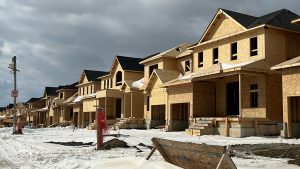Have you ever found yourself driving, walking or cycling northbound down a major corridor in Vancouver, only to pause to look at the mountain peaks, famously known as “The Lions” to the First Nations people?
There is growing concern these unobstructed views may be in jeopardy, framed as a false choice by the City of Vancouver between affordable housing or preserving views, said Larry Beasley a former co-chief planner for the City of Vancouver, the founding principal of Beasley and Associates and a ‘distinguished practice’ professor of planning at the University of British Columbia.
“It’s fundamentally wrong to say the answer to affordability is to give up quality of life,” Beasley said, who urged citizens to write postcards to the city. “We need a strategy for secure housing.”
He was one of the speakers during an event hosted by Simon Fraser University’s City Program and Urban Studies department coined Vancouver’s View Protection Policy — How it Developed and Was Implemented. He was joined by Peter Busby, a principal with Perkins & Will in Vancouver, who described the approach taken by city planners and architects including the creation of a comprehensive 3D model of Vancouver that included “view cones” to showcase lines of sight to notable landmarks.
Many may not realize the city’s view stems from a policy drafted in the late ‘80s, the result of a rigorous consultation process.
Beasley emphasized the policy’s importance in preserving spaciousness and a connection to nature and pointed out how it ensures scenic views are accessible to the broader public, not just to a few residing in luxury highrises.
“There is tangible financial as well as experiential value to the view corridors and there is important value for our economy because it sets the very image of our city,” he said.
Beasley noted the absence of a permanent director of planning with the city is also cause for concern. His remarks were particularly poignant given the event’s timing, coinciding with Mayor Ken Sim’s controversial decision to dissolve the park board.
He offered alternative solutions to preserving views while accommodating urban growth. He emphasized the need for innovative thinking beyond simply adding more buildings to the already dense downtown core.
One geographical solution he proposed involves the area west of Clark Drive, characterized by sloping land currently occupied by warehouses. Beasley suggested this area could be transformed to mixed-use highrise buildings, potentially housing up to 12,000 people.
“We have this idea that anything that’s industrial, even if it’s in the heart of the city, has to be preserved,” he said. “I just think that has to be thought about more intelligently with all the other needs we have.”
He also proposed an organizational approach inspired by a model in Madrid and similar to Whistler’s Employee Restricted Housing Program with some key differences.
This involves a non-profit home ownership program, designed to help residents build equity and legacy for their families. The model would require a collaboration between government and private sectors, offering a gateway into home ownership. Participants could build enough equity to eventually enter the regular housing market. This approach, Beasley argued, could provide a sustainable solution to the housing affordability crisis, while preserving the city’s architectural heritage and views.
The concept of affordability through security was also discussed, emphasizing the need for government funding. One example cited was the Great Northern Way area, a city-approved proposal that focuses on creative worker housing, offering rental options to maintain a level of affordability.
City councillor Pete Fry, who had previously voted in favour of refining the View Protection Policy, expressed his belief that completely scrapping the policy would be a regressive step for the city.
“I’m a big believer in making things less bad and figuring out how we can find compromises,” Fry stated. “So, when they come back with a proposal to pick option A, B, or C, what does a less bad option look like? Are there some views that we should sacrifice, or should we adopt a blanket approach because we have to recognize the practical implications?”
In response, the two-man panel cautioned against precipitous decisions regarding the policy, especially when there is the added pressure of two big development proposals waiting for the city to eliminate the view protections in order to greenlight those projects.
Instead, Beasley and Busby advocate for an exhaustive review, emphasizing the importance of considering long-term impacts on Vancouver’s landscape.
“It should be in parallel with another study, which shows what density and height opportunities are available outside the corridors, like the False Creek Flats and Broadway corridor,” said Busby. “There is an awful lot of potential that could probably tell you where a quarter million people could be housed.”











Recent Comments